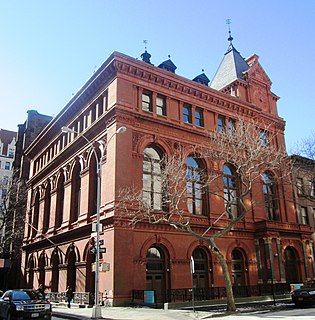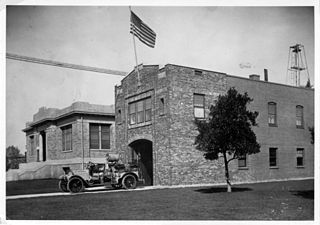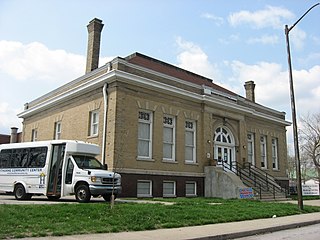
The Center for Brooklyn History is a museum, library, and educational center founded in 1863 that preserves and encourages the study of Brooklyn's 400-year history. The center's Romanesque Revival building, located at Pierrepont and Clinton Streets in Brooklyn Heights, was designed by George B. Post and built in 1878-81, is a National Historic Landmark and part of New York City's Brooklyn Heights Historic District. The CBH houses materials relating to the history of Brooklyn and its people, and hosts exhibitions which draw over 9,000 members a year. In addition to general programming, the CBH serves over 70,000 public school students and teachers annually by providing exhibit tours, educational programs and curricula, and making its professional staff available for instruction and consultation.

The Havana Public Library is a Carnegie library located at 201 W. Adams St. in Havana, Illinois. The library was built in 1902 to house Havana's library program, which began in 1896 and was previously kept in a room of the city hall. The building's construction was funded by an $8,000 grant from the Carnegie Foundation as well as a local library tax. The blond brick building was designed in the Classical Revival style. The front of the building features four bays separated by five Ionic pilasters, an asymmetrical pedimented entrance, and a stepped parapet atop the entrance bay.

The Vienna Public Library, also known as Vienna Carnegie Library, is a Carnegie library at 401 Poplar St. in Vienna, Illinois. It was built in 1911 with a $5000 grant from the Carnegie Foundation. The brick building, designed by local architect Thomas Clymer, features a tall flight of stairs leading to the front entrance; two pilasters flank the staircase. The building provided a permanent home for Vienna's library program, which was established in 1895 and had rotated through a number of local buildings prior to 1911. County medical services have also been based in the library: The American Red Cross used the building as its headquarters during a 1917 influenza outbreak, and a trachoma clinic operated in the basement from 1936 to 1964. The building has also been used as a gym, a headquarters for city services, and a meeting place for several women's organizations and the Johnson County Historical Society.

The Arcola Carnegie Public Library is a Carnegie library located at 407 E. Main St. in Arcola, Illinois. The library was built in 1905 through a $10,000 grant from the Carnegie Foundation. Architect Paul O. Moratz designed the library in the Classical Revival style. The building's front entrance is situated within a Classical gabled portico supported by stone pilasters. The hipped roof of the building features an ornamental cornice along its edge and a cupola at its peak. The building still serves as Arcola's public library and houses a collection of over 18,000 books.

Danville Public Library is a library in Danville, Illinois formed in 1883 by consolidating several existing collections. Originally it existed in rented space in buildings in downtown Danville. On November 7, 1904, a new Carnegie library opened and served for the next 91 years. The library had a Beaux-Arts design with columns flanking the front doors and a parapet wall above the entrance. It was expanded in 1929 thanks to a gift from Augustus Webster.

The Sacramento City Library, also known as Central Branch, is part of the Sacramento Public Library system, and faces I Street in Sacramento, California near Sacramento City Hall.

This is a list of the National Register of Historic Places listings in Columbiana County, Ohio.

The Johnstown Flood Museum is a history museum located in Johnstown, Pennsylvania, dedicated to the Johnstown Flood of 1889. The museum is housed in the former Cambria Public Library, which is part of the Downtown Johnstown Historic District.

The Everett Carnegie Library is a Carnegie library building located in Everett, Washington, USA listed on the National Register of Historic Places and part of the Snohomish County Government campus. The building occupies the southeast corner of the intersection of Oakes Avenue and Wall Street in the city's central business district.

The Carnegie Library is a historic building on the Fisk University campus in Nashville, Tennessee. The cornerstone was laid in 1908 by William Howard Taft, who was then the U.S. Secretary of War. It was funded by Andrew Carnegie, who provided a number of academic libraries, as well as many public Carnegie libraries.

The Carnegie Library, historically known as the Upland Public Library, is a Carnegie library located at 123 East D Street in Upland, California. Built in 1913, the library was the first public building in Upland. Architect Homer W. Glidden designed the library in the Classical Revival style. The library's design features a projecting central entrance with a plain frieze supported by two columns and brick pilasters, a stucco parapet extending around most of the building, and a cornice set above dentils. The building served as a library until 1969, when the library moved to a new building. The City of Upland still owns the building and rents it to the public for community events. It is also used by the Upland Public Library to house its Literacy Program.

The Atlanta Public Library, located at the intersection of Race and Arch Streets in Atlanta, Illinois, was built in 1908 and has operated continuously as a library since. Architect Paul A. Moratz's design combines the Neoclassical with an octagonal plan, an uncommon mixture of styles. The building's eight sides are all symmetrical except for the front, which is broken by a classical portico with Doric columns and a round arched entrance. The library is topped by a red tile roof.

The Carnegie Library of Albany is a Carnegie library in Albany, Missouri, listed on the National Register of Historic Places. It was designed by Edmond J. Eckel and opened in 1906.

The Litchfield Public Library is a Carnegie library located at 400 N. State St. in Litchfield, Illinois. The library was built in 1904-05 through a $10,000 donation from the Carnegie Foundation. Litchfield's library program had been in existence since 1882; prior to the construction of the library, it had been housed in the Cline Building and later the First National Bank, but by the early 1900s it had outgrown these spaces. Architect Paul Moratz designed the library building in the Classical Revival style. Litchfield's Women's Club and Chamber of Commerce ran the library for its first few decades and provided funds for improvements such as restrooms. In addition, a children's library program began in 1914 through the assistance of the public school system. The library still serves Litchfield and holds a collection of 34,000 books.

The Jacksonville Public Library is a Carnegie library located at 201 West College Avenue in Jacksonville, Illinois. The library was built in 1902 to house the city's library program, which began in 1870. Chicago architects Patton & Miller designed the Classical Revival building. The building still houses the city's public library and is listed on the National Register of Historic Places.

Union City Public Library is a historic Carnegie library building located at Union City, Randolph County, Indiana. A grant request application was sent to Andrew Carnegie in the Fall of 1903, announcement for the approval of the grant was received in Union City in early December 1903, construction bids were taken in early 1904, ground was broken and foundation construction was started in early June 1904, and the building was completed and the library's collection installed in May, 1905, in time for a public grand opening and celebration held on June 8, 1905. The structure, of which the final design was approved by Carnegie, is a Classical Revival style Indiana limestone building with an upper main floor, and a former basement storage area which has been converted over for a youth services library and programing. Its design features a wooden pediment supported by four Corinthian order limestone columns and a wood balustrade. Its construction was funded by a $10,000 grant from the Carnegie Foundation.

Hawthorne Branch Library No. 2, also known as Hawthorne Education Annex, is a historic Carnegie library building located in Indianapolis, Marion County, Indiana. Built in 1909–1911, with funds provided by the Carnegie Foundation, it is a one-story, rectangular, Classical Revival style brick and limestone building on a raised basement. It has a truncated hipped roof and features a slightly projecting pavilion housing a round arch. It was renovated in 1955, after its closure as a library, and again in 1999.

Indianapolis Public Library Branch No. 6, also known as Spades Park Library (Carnegie), is a historic Carnegie library located in Indianapolis, Indiana. It was built in 1911–1912, and is a two-story, "L"-shaped, Italian Renaissance style masonry building on a raised basement. It has a terra cotta tile hipped roof, decorative brickwork, limestone accents, and elements of American Craftsman and Arts and Crafts style decorative elements. It was one of five libraries constructed from the $120,000 the Carnegie Foundation gave the City of Indianapolis in 1909 to be used towards the construction of six branch libraries. The library remains in operation as the Spades Park Branch of the Indianapolis Public Library.

The De Soto Trail Regional Library System is a public library system serving the counties of Mitchell, Baker and Early, in the state Georgia. The headquarters of the library system is the Camilla Public Library located in Camilla, Georgia.

The Streator Public Library is a historic Carnegie library located at 130 S. Park Street in Streator, Illinois. Opened in 1903, the library was the first permanent home for Streator's library association. Architects Patton & Miller designed the Classical Revival building. The library is listed on the National Register of Historic Places and is still home to Streator's main public library.






















